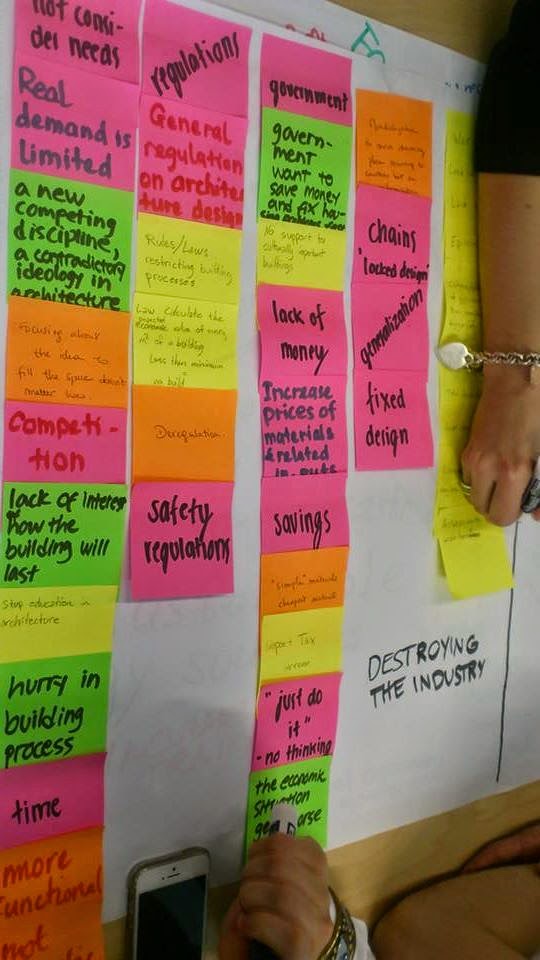For this work
day we moved again and this time we were in a room in kåren, empty but with a
platform suggesting that usually it must be a theater. The main task of this work day was to explore
a given theme through different tools. We were given
the topic “Idea flows and creativity between people” to work on.
The
first task was to develop ideas related to the topic by drawing a tree. First, we started to discuss the topic but our
ideas being limited, we decided to open our mind with internet and luckily we
found an interesting article regarding idea development and human creativity
management, skimming through the article, we extracted some key words.

We
found some really good points to place as big branches for our tree, including
Exploring, Communication, Diversity, Spreading, Combining and Anticipation.
Also, we noticed in the text that Evaluation and Elimination are other
important words linking the above main points together. We placed those two in
the picture as the air surrounding the whole tree. Some fruits were also drawn
to symbolize innovation gained by effective idea flows and people’s creativity
management. This task was really useful to help us to figure out all the ideas
we have about the subject. We were first a bit skeptical because we didn't got
from the beginning the goal of this tree but it became more clear when we start
the second task. Taking this into account, next time we will certainly manage
this tree better. Regardless to that we can quickly see the limits of this tool
that´s why, this tree worked well as a warm-up for the assignments that we got
to discuss widely about the theme but it seems difficult to use it alone to
create innovation or even figure out new ideas.

After
the tree-drawing exercise, we had a short break and we started playing
“sculpture game”, in which, we had to form small group of two or three and help each other
forming shapes of the a ballet dancer and ice-hockey player. It was funny, and
it helps also to awaken our imagination.
Then
we came back to the main task and in the next activity we were supposed to
apply one of the two new tools we have chosen during the week, thus, we applied
the Lotus Blossom. According to the
description we made in a previous article (http://supervision58h.blogspot.fi/2015/03/this-week-we-decided-to-present-two-new.html), we tried first to bring out eight main ideas linked to our
theme i.e. “Idea flows and creativity
between people. Pursuant to Joachim suggestion about the importance to let the
ideas going before starting to analyze them ; we gave each member about 5
minutes to write down her/his thoughts on sticker notes. After that, each of us
read out loud her/his ideas for other to cross the overlapped ones and
collected 8 statements for the next step. Thanks to this method we underlined eight related
subheadings as: Communication/Network,
Diversity, Exploring, Anticipation, Spreading ideas, Idea combination and
Outsiders consulting.

We continued our ideas development by
doing the same thing with each of the statements had from the previous step.
This tool works really well in terms of creating a lot of ideas and helping
group members understand each other’s thoughts. It is a clear and systematic
process to keep the flow of ideas to a very specific and practical result. But
our time being limited, it was not possible for us to finish to explore every
idea deeply, thus, there are also some weaknesses of the tool such as time
costing. Furthermore, we also realized that this tool will certainly not
suitable for a big group. Fortunately or unfortunately during the first part of
the work day we were three so it was easier to work on it.
After
a short presentation of our ideas and the tool we used, the next task consisted
to use the last tool left. Thus, we used the Visioning tool (http://supervision58h.blogspot.fi/2015/03/this-week-we-decided-to-present-two-new.html).
At the beginning,
most of us thought that the tool is good for a business situation rather than
such case of a simple statement. So we were uncertain whether we should use it
at all, since we thought it would be hard to create a vision of merely a
concept. Rather than giving up, we decided to take it as a challenge and keep
going. We had the idea of creating a vision of what the circumstances would
look like in order to support the “Idea flows and creativity between people”. Everyone
took some time to think about our own real experience on the best situations
for new ideas creation, we combined all those separate notes together.
Based on
that, our vision regarding idea flows and creativity between people has been
built:
Teams built on the foundation of trust, engage to the problem solving
process by stopping to think, focus on the context, comparing alternatives and
dare to share. This vision built on the core element, would give us direction
for future creative work, which is the purpose of a vision, it would be our director
thread.
This
work day was really interesting. We learned more about the skills and
weaknesses of everyone and therefore, we are more and more able to deal with.
Consequently we think that we can say that we are becoming more and more
efficient..













